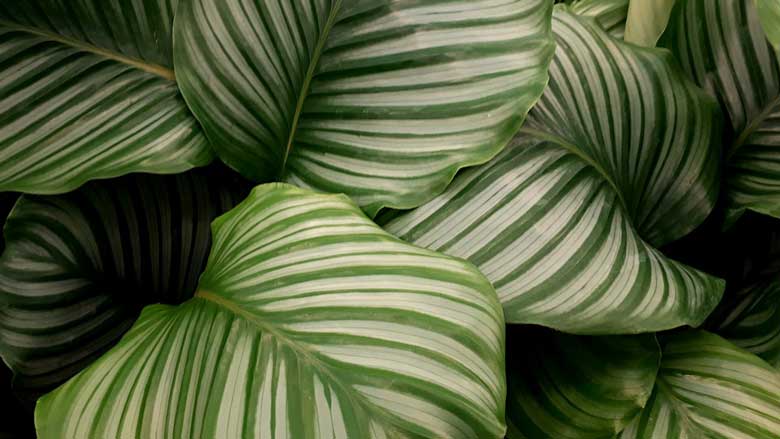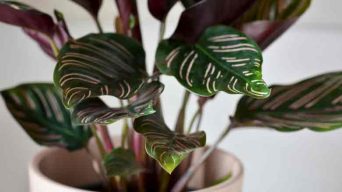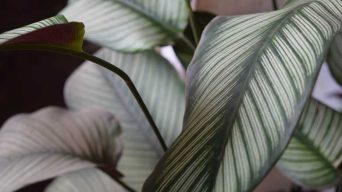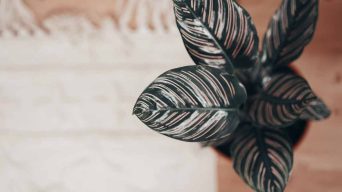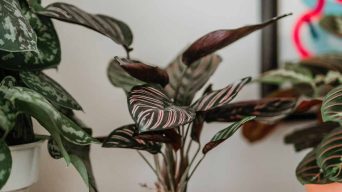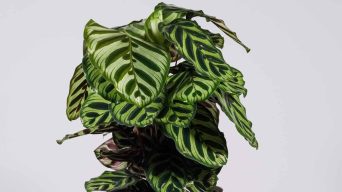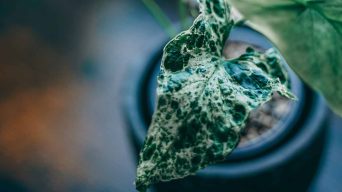The Calathea plant, also known as the prayer plant, is a tropical plant known for its vibrant leaves.
However, if your Calathea leaves turn yellow, something might be wrong.
This is a common problem with Calatheas, with several possible causes.
Here we will explore some possible causes of Calathea leaves turning yellow and how to solve the problem.
Why Are My Calathea Leaves Yellowing?
The Calathea plant is a popular indoor plant known for its beautiful leaves.
Gardeners often find that their Calathea plants struggle to thrive indoors, as they require a high level of humidity and indirect light to stay healthy.
If these conditions are not met, the leaves of the Calathea can become yellow and wilted, making it important to provide the right environment for your Calathea to flourish indoors.
Calathea leaves can be green, purple, or pink, often variegated with different colors on the same leaf.
They are generally easy to care for, but their leaves can sometimes turn yellow.
Houseplants are a great way to add life to any home. However, if their leaves start to turn yellow, it could be due to a variety of factors.
The best way to remedy the situation is to identify the cause and take appropriate steps to fix it.
If your Calathea leaves are turning yellow, the first thing you should do is identify the cause.
Here are some of the most common causes of Calathea leaves turning yellow:
1. Low Humidity
While there are several potential causes of this issue, low humidity is one of the most common.
Calathea plants originate from tropical rainforests, where humidity levels are high.
Calathea foliage may begin to turn yellow in lower humidity environments and develop brown tips.
This problem is often compounded by dry air from heating and cooling systems, which can cause the leaves to become even more dehydrated.
How To Fix It:
Calathea plants need high humidity to stay healthy, so you need to increase the humidity level if your plant is in a low humidity environment.
If the humidity level in your home is below 50%, you can increase it by placing the plant on a tray of wet pebbles.
You can also use a humidifier to increase the humidity level in the room or mist the plant’s leaves with water a few times a day.
Keep in mind that overwatering can also cause yellow leaves, so be sure not to water the
2. Overwatering
Issues such as overwatering can cause Calathea leaves to turn yellow, so it is important to be mindful of this and other potential problems when caring for your Calathea plant.
If the plant is constantly wet, the roots will become waterlogged, and the leaves will turn yellow.
When Calathea plants receive excessive watering, their roots are deprived of the necessary oxygen from the soil.
This lack of oxygen causes the leaves to turn yellow, brown, and die.
How To Fix It:
If you have an overwatered Calathea plant, the first thing you need to do is stop watering it.
Wait until the top inch of soil is dry before watering again.
Calatheas need to be watered sparingly, so be sure not to water the plant more than once a week.
You can also improve your pot’s drainage by adding pebbles to the bottom or planting the Calathea in a pot with a drainage hole.
3. Underwatering
Insufficient watering is a prevalent cause of yellowing leaves in Calathea plants.
Calathea plants are native to tropical regions and require high humidity and consistent moisture to thrive.
When the soil is dry and the roots are not getting enough water, the plant won’t be able to take up the nutrients it needs, and the leaves will start to turn yellow.
How To Fix It:
If your Calathea plant is experiencing insufficient watering, the initial step is to increase the frequency of watering.
Water the plant when the top inch of soil is dry, and give it plenty of water.
When watering, use room-temperature water and allow the potting mix to moisten evenly.
Allow any excess water to drain before putting the Calathea back in its spot.
4. Water Quality
If your Calathea leaves turn yellow, it may be due to the water quality you are using.
The chemicals in tap water can cause the leaves to turn yellow and even brown.
If you notice your Calathea’s leaves are turning yellow, it’s essential to check the quality of your water.
Calatheas are very sensitive to fluoride, chlorine, and other tap water chemicals.
These chemicals can damage the leaves and cause them to turn yellow.
Also, if the water is too hard, it can cause a build-up of minerals on the leaves and cause them to turn yellow.
How To Fix It:
If the water you are using is causing your Calathea leaves to turn yellow, you need to use filtered or distilled water instead.
You can also use rainwater or bottled water to water your Calathea plant.
Another option is to let the water sit out overnight so the chlorine and other chemicals can evaporate. Then, use the water to water your Calathea.
5. Over-fertilization
If your Calathea leaves turn yellow, it may be due to too much fertilizer.
When Calatheas are fertilized too frequently or with too strong of a solution, the excess nutrients can build up in the soil and cause yellow leaves.
In addition, overfertilization can also lead to leaf scorch, a condition in which the tips and margins of the leaves turn brown and dry.
How To Fix It:
If you think your Calathea leaves are turning yellow due to too much fertilizer, you first need to stop fertilizing it.
Flush the soil with water to remove excess fertilizer, and wait a few weeks before resuming fertilization.
Be sure to use a weaker solution when fertilizing again and only once a month during the growing season.
6. Poor Lighting
The lack of light can cause Calathea yellow leaves because the plant needs energy from the light to photosynthesize and produce the necessary nutrients for healthy growth.
Calatheas need bright indirect light to stay healthy and produce lush green leaves.
If the plant is not getting enough light, the leaves will turn yellow, and the Calathea will eventually die. This is because the plant is not able to produce enough chlorophyll.
Chlorophyll is essential for photosynthesis; without it, the plant will not be able to generate the food it needs to survive.
How To Fix It:
If your Calathea needs more light, you first need to move it to a brighter spot.
Place the plant near a window where it will get indirect sunlight. The best place for a Calathea is in a north- or east-facing window.
Calatheas need at least six hours of bright light a day, so if you can’t move the plant to a sunnier spot, you may need to consider adding some artificial light.
7. Too Much Direct Sunlight
If your Calathea leaves turn yellow, it may be due to too much sunlight.
Calathea plants are native to tropical rainforests, where they grow in dappled sunlight under the canopy of tall trees.
In their natural habitat, Calathea plants never receive direct sunlight.
When grown as indoor plants, Calatheas need bright indirect light to thrive.
If they are placed in a spot that receives too much direct sunlight, Calathea plants can sunburn, and the leaves will turn yellow.
How To Fix It:
If your Calathea is in a spot that receives too much direct sunlight, you first need to move it to a place where it will get more indirect light.
Place the plant near a window where it will get dappled sunlight. The best place for a Calathea is in a north- or east-facing window.
A Calathea plant needs at least six hours of bright indirect light daily.
If you can’t move the plant to a spot with more indirect light, you can use a sheer curtain or blinds to diffuse the sunlight.
8. Cold Temperatures
If your Calathea leaves turn yellow, it may be due to cold temperatures.
Calathea plants are native to tropical climates and do not do well in cold temperatures.
The leaves may be turning yellow because the plant is stressed from the cold.
Another reason is that Calathea leaves are sensitive to changes in temperature and light.
The leaves may turn yellow if the plant is suddenly exposed to colder temperatures.
How To Fix It:
If your Calathea is in a room that is too cold, you first need to move it to a warmer spot.
Place the plant near a window where it will get more direct sunlight.
You can also use a grow light to give the plant some extra light.
If you cannot move the plant, you can use a space heater to warm up the room.
9. Heat Stress
Another possibility is that your Calathea is experiencing heat stress.
While Calatheas are native to tropical regions and thrive in warm climates, they can be sensitive to sudden changes in temperature.
When Calatheas are exposed to excessive heat, their leaves may turn yellow and brown.
In some cases, the Calathea leaves may also curl or turn crispy.
If Calatheas are not given enough water, they may also experience heat stress.
In addition to turning yellow, the leaves may become dried and brittle.
How To Fix It:
If you believe your Calathea is experiencing heat stress, the best thing to do is move it to a cooler spot.
Calathea plants thrive in temperatures between 65 and 80 degrees Fahrenheit.
If the plant is in a too warm room, move it to a cooler room or an area with more shade.
You can also increase the humidity in the room by using a humidifier and misting the plant regularly.
10. Pest Infestation
Another reason Calathea’s leaves may turn yellow is that the plant is infested with pests.
Pests affecting Calathea plants include mealybugs, spider mites, scale insects, and aphids.
There are several reasons why pests may cause Calathea yellowing leaves.
One possibility is that the pests are feeding on the leaves, which can damage the plant and cause the leaves to turn yellow.
Another possibility is that the pests are carrying a disease infecting the Calathea plant, which can also cause the leaves to turn yellow.
Finally, it is also possible that the pests are simply stressing the Calathea plant, which can also cause yellow leaves.
How To Fix It:
If you believe your Calathea is infested with pests, you first need to take a closer look at the plant.
Check the undersides of the plant leaves for any evidence of pests.
If you find evidence of pests, you need to take action to eliminate them.
Several ways to get rid of pests include insecticidal soap, horticultural oil, or neem oil.
You can also spray the plant with a strong stream of water to dislodge any pests or remove them by hand using a damp cloth with soap.
11. Nutrient Deficiency
Another possibility is that your Calathea is experiencing a nutrient deficiency.
Calathea plants require high nitrogen, potassium, and phosphorus levels to stay healthy.
If these nutrients are lacking in the soil, Calathea leaves will begin to turn yellow.
In some cases, leaves may also develop brown spots or edges.
How To Fix It:
If you believe your Calathea is experiencing a nutrient deficiency, the best thing to do is fertilize the plant.
You can use a high-quality fertilizer that contains a balance of all the essential nutrients that Calatheas need.
You can also add compost to the soil to help improve nutrient levels.
In addition, changing the potting soil every year or so can also help to improve nutrient levels.
12. Poor Soil Drainage
Another possibility is that your Calathea plant is in a pot with poor soil drainage.
Calathea plants do best in pots with a soil mix that drains well.
If the potting soil does not drain well, water will become trapped in the soil and can cause Calathea roots to rot.
How To Fix It:
If you believe your Calathea is in a pot with poor soil drainage, the best thing to do is repot the plant into a pot with better drainage.
Use a potting mix that is light and drains well.
To ensure the plant is able to drain properly, also make sure the container has drainage holes at the bottom so that excess water can escape and not cause the roots to become waterlogged.
You can improve the soil’s drainage by mixing in some sand or perlite.
You can also improve the pot’s drainage by putting a layer of gravel or broken pots at the bottom.
13. Adjusting to a New Environment
Another possibility is that your Calathea is adjusting to its new environment.
The main reason is that Calathea plants are susceptible to changes in their surroundings.
When they are moved to a new location, or even when the temperature or humidity in their current location changes, Calathea leaves can turn yellow as the plant tries to adjust.
How To Fix It:
If you believe your Calathea is adjusting to its new environment, the best thing to do is give it some time.
The plant will eventually adjust to the new environment, and the leaves will return to their normal color.
In the meantime, keep the temperature and humidity in the room as consistent as possible.
14. Natural Leaf Drop
Another possibility is that your Calathea is simply dropping its leaves as part of its natural growth cycle.
Calathea plants typically drop their leaves once they have reached maturity.
As Calathea leaves mature, they slowly begin to lose their green pigment.
This process is accelerated by exposure to direct sunlight, which bleaches out the chlorophyll in the leaves.
Eventually, the leaves turn yellow and then brown as they die off. While this is a natural process, it can be unsightly in a houseplant.
How To Fix It:
If you believe your Calathea is dropping its leaves as part of its natural growth cycle, the best thing to do is wait.
The leaves will eventually fall off and be replaced by new, healthy leaves.
In the meantime, keep the plant in a location where it receives indirect sunlight so the leaves don’t bleach out.
Should I Cut Yellow Leaves off Calathea Plants?
When a Calathea leaf starts to turn yellow, it can be alarming. It’s natural to wonder if you should cut the yellow leaf off.
The answer is: it depends.
If the leaves are only starting to turn yellow, then it’s likely that the plant needs a little bit of extra care. Try to determine the cause of the yellowing and address that.
If the leaves are mostly yellow and starting to dry out, it’s time to cut them off.
This will help keep the plant healthy and encourage new growth by removing the leaves that no longer support the plant.
Final Thoughts
Calathea is a popular indoor plant that is known for its beautiful leaves.
If your Calathea leaves are turning yellow, there may be a few reasons.
However, it is due mainly to overwatering or lack of light.
Be sure to water your Calathea sparingly and give it plenty of bright indirect sunlight.
With proper care, your Calathea leaves should stay green and healthy, making your home and garden look vibrant and beautiful.

